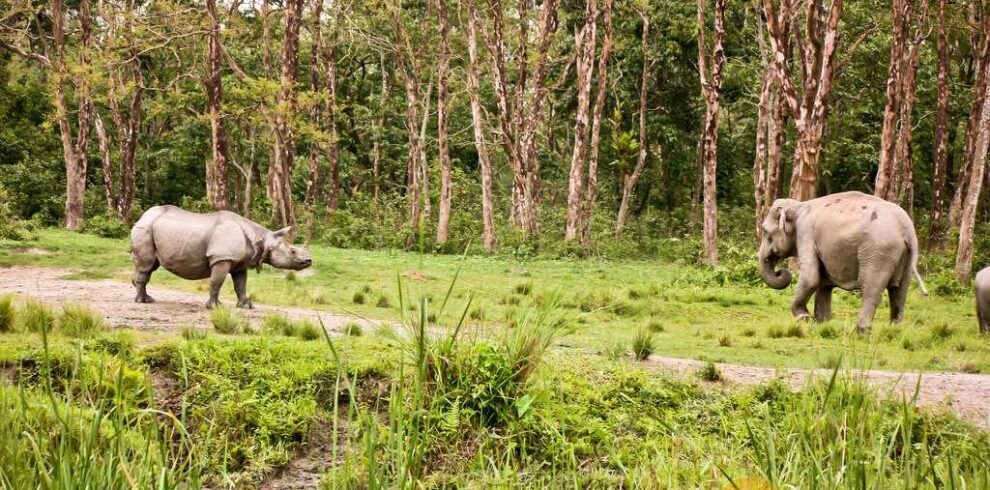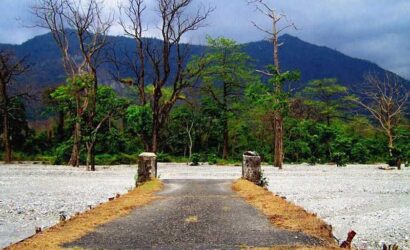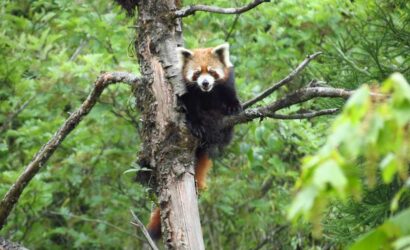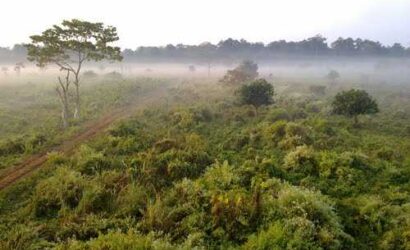The Jaldapara National Park which is located in the eastern foothills of the Himalayas, are well-known for their one-horned rhinoceroses, elephants, Bengal tigers, spotted deers, barking deers, sambhar deers, bison, wild pigs, hog deer, and bison.
With a sizable variety of eagles, Bengal floricans, Indian Hornbills, jungle fowl, pea fowl, patridges, and other birds, the skies here will also be a part of your tourist destination. Eagle species like the fishing eagle and crested eagle can also be sighted. Additionally, the adjacent Gorumara National Park and the remnants of an old fort inside the Chilapata Forest are well worth visiting. You can ride an elephant through the park because Jaldapara is known for having a large population of elephants. You might also use one of the hired safaris as an alternative.
From the Bhutan border near Totopara in the north to the Mathurabagan tea estate in the south, Jaldapara’s forests stretch from north to south. The woodland spans over 50 kilometers. The forest is just 5 to 7 km wide for the majority of the route, though. National Highway 317 runs through the forest’s northern edge. In the past, there used to be a lot of tourist activity in the vicinity of this highway.
Jaldapara National Park Wildlife
The Asiatic one-horned rhino, which may be viewed from an elephant’s back while on a Jeep safari or from a watchtower, is Jaldapara’s main tourist draw in addition to its outstanding natural beauty. After Kaziranga National Park in Assam, the National Park is home to India’s biggest population of rhinos.
Elephants can be seen ambling through the forest and frequenting the rivers, open grasslands, and glades. At the Hollong lodge’s window sill, enormous Tuskers and Makhnas, Gaur, Hog Deer, Spotted Deer, majestic pied Hornbills, vibrant Green Pigeons, Peafowl, and other feathered beauties will welcome your gaze.
In the morning, an exciting elephant ride will take you deep into the grassland for real exhilaration. In Jaldapara, views like rhinoceros in a dirty pond, an elephant herd, or racing deer are exhilarating. Please be aware that reservations for the elephant rides must be made on-site and cannot be made in advance.
The few elephants that are accessible cannot accommodate the vast number of visitors who swarm to the Park for the most of the year. The other option for visiting inside the forest is a Jeep safari.
Accommodations in Jaldapara National Park
A town with a woodland edge, Madarihat is located along this roadway. The majority of the accommodations and resorts, as well as the lodging provided by the tourism office, are centered in Madarihat. There are now many more tourist resorts in the area, and most people refer to Madarihat and its surroundings when they use the name Jaldapara.
Jaldapara is really the name of a market and settlement in the southern portion of the forest. There aren’t many places to stay in this area of the forest, which is often less popular with tourists. In close proximity to the Madarihat – Falakata Highway 12, which runs parallel to the forest from north to south, more recent tourist lodgings are sprouting up.
How to Reach Jaldapara National Park
Only 7 kilometers separate the sanctuary and the closest railhead, Madarihat, but few trains stop there. The sanctuary is around 20 kilometers away, so it is advised to take a train to Birpara or Hasimara. You may get a taxi to the refuge from these stations.
The closest airport is located in Bagdodara, close to Siliguri, some 140 km away, and from there, one can take a bus or a taxi to reach Jaldapara. From Kolkata, visitors can alternatively take a bus or cab to get here. The capital city of West Bengal, Kolkata, has excellent train connections to the rest of the nation.
Best time to visit Jaldapara National Park
The best time to visit Jaldapara is from September to May, however you should avoid the monsoon season because the park is closed then. Despite the national park’s plenty of adventure and excitement, there aren’t many culinary alternatives or food cultures there. As a result, the region lacks any special or distinctive cuisine. However, for tourist purposes, the hotels and resorts offer excellent dining options.
Nearby Places To Visit
Chilapata
The undisturbed area of forest is split by the River Torsa, with Jaldapara on the western side and Chilapata on the eastern. Recently, Chilapata has gained popularity as a tourist attraction. With the forest department’s approval and in the company of a certified guide, you can visit a forest. Since the trip is only about 15 kilometers, Chilapata can easily be visited as part of a day-long sightseeing tour from Jaldapara.
The ruins of the fort of Nal King, which dates back a thousand years and is of immense historical and archaeological significance, are tucked away deep within the forest. The remains, which were constructed in the 5th century under the Gupta Empire, still evoke recollections of the Golden Age.
Khairbari
On the west side of Jaldapara woodland, there is a little patch of forest here. South Khairbari Leopard Rescue Center is a leopard rescue facility located in Khairbari. “Khairbari Royal Bengal Tiger Rehabilitation and Research Center” is the new name of the facility.
Since the majority of the circus tigers here have passed away from old age, the population of tigers is slowly declining. There are still plenty of leopards at Khairbari. From Jaldapara, the rescue center is roughly 10 miles away.
Totopara
A popular destination for those interested in ethnic tourism is Totopara, which is close to the Jaldapara National Park. The Totos, one of the most endangered ethnic groups in the world, have only ever lived in Toto Para. They are currently just about a thousand strong.
Governmental and non-governmental organizations have undertaken numerous measures to improve their living conditions. Living beside them and seeing their customary customs can still be a priceless experience. Even if you’re short on time, you can include a trip to Totopara in your itinerary of local sightseeing.
Bhutan Border
Only 25 kilometers separate Jaldapara from Phuentsholing via Hasimara. There are no requirements to enter the border town. Many people take a half-day journey from here to Phuentsholing. You can stop in Jaldapara for the night if you’re traveling to Bhutan.




